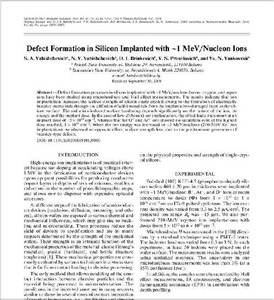Please use this identifier to cite or link to this item:
https://elib.psu.by/handle/123456789/3027Full metadata record
| DC Field | Value | Language |
|---|---|---|
| dc.contributor.author | Вабищевич, С. А. | - |
| dc.contributor.author | Вабищевич, Н. В. | - |
| dc.contributor.author | Бринкевич, Д. И. | - |
| dc.contributor.author | Просолович, В. С. | - |
| dc.contributor.author | Янковский, Ю. Н. | - |
| dc.date.accessioned | 2014-06-25T10:34:32Z | - |
| dc.date.available | 2014-06-25T10:34:32Z | - |
| dc.date.issued | 2010 | - |
| dc.identifier.citation | Особенности дефектообразования в кремнии, имплантированном ионами с удельной энергией 1 МэВ/нуклон / С. А. Вабищевич [и др.] // Неорганические материалы. – 2010. – Т. 46, № 12. – С. 1413-1417. - Режим доступа: http://www.maikonline.com/maik/showArticle.do?auid=VAGI2RG3Q3&lang=ru | ru_RU |
| dc.identifier.other | http://cyberleninka.ru/article/n/harakteristicheskoe-singulyarnoe-integralnoe-uravnenie-s-yadrom-koshi-v-isklyuchitelnom-sluchae | - |
| dc.identifier.uri | https://elib.psu.by/handle/123456789/3027 | - |
| dc.description | Osobennosti defektoobrazovanija v kremnii, implantirovannom ionami s udel'noj jenergiej ∼1 MjeV/Nuklon /S. A. Vabishhevich [i dr.] // Neorganicheskie materialy. - 2010. - T. 46. - № 12 (Dekabr'). - S. 1413-1417 | ru_RU |
| dc.description.abstract | Defect formation processes in silicon implanted with ∼1 MeV/nucleon boron, oxygen, and argon ions have been studied using microhardness and Hall effect measurements. The results indicate that ion implantation increases the surface strength of silicon single crystals owing to the formation of electrically inactive interstitials through the diffusion of self-interstitials from the implantation-damaged layer to the silicon surface. The radiation-induced surface hardening depends significantly on the nature of the ion, its energy, and the implant dose. In the case of low-Z (boron) ion implantation, the effect had a maximum at an implant dose of ∼5 × 1014 cm−2, whereas that for O+ and Ar+ ions showed no saturation even at the highest dose reached, 1 × 1016 cm−2. When the ion energy was increased to ∼3 MeV/nucleon (210-MeV Kr+ ion implantation), we observed an opposite effect, surface strength loss, due to the predominant generation of vacancy-type defects. | en_EN |
| dc.description.abstract | Методами измерения микротвердости и эффекта Холла исследованы процессы дефектообразования в кремнии, имплантированном ионами бора, кислорода и аргона с удельной энергией ∼1 МэВ/нуклон. Показано, что имплантация приводит к приповерхностному упрочнению монокристаллов кремния, обусловленному электрически неактивными дефектами межузельного типа, формирующимися в процессе диффузии к поверхности кремния собственных межузельных атомов из нарушенного ионной имплантацией слоя. Величина приповерхностного радиационного упрочнения существенно зависит от вида, энергии и дозы имплантируемых ионов. При имплантации легких ионов B+ указанный эффект достигал максимума при дозе ∼5 × 1014 см–2, а для ионов O+ и Ar+ не выходил на насыщение даже при максимальной дозе 1 × 1016 см–2. При увеличении удельной энергии ионов до ∼3 МэВ/нуклон (имплантация Kr+, 210 МэВ) наблюдается обратный эффект приповерхностного разупрочнения, обусловленный формированием радиационных дефектов преимущественно вакансионного типа. | ru_RU |
| dc.language.iso | ru | ru_RU |
| dc.subject | ЕСТЕСТВЕННЫЕ И ТОЧНЫЕ НАУКИ | ru_RU |
| dc.subject | Физика | ru_RU |
| dc.title | Особенности дефектообразования в кремнии, имплантированном ионами с удельной энергией ∼1 МэВ/Нуклон | ru_RU |
| dc.title.alternative | Defect formation in silicon implanted with ∼1 MeV/nucleon ions | en_EN |
| dc.type | Article | ru_RU |
| Appears in Collections: | Публикации в зарубежных изданиях | |
Files in This Item:
| File | Description | Size | Format | |
|---|---|---|---|---|
| Vabishevich_2010.pdf | 113.65 kB | Adobe PDF |  View/Open |
Items in DSpace are protected by copyright, with all rights reserved, unless otherwise indicated.